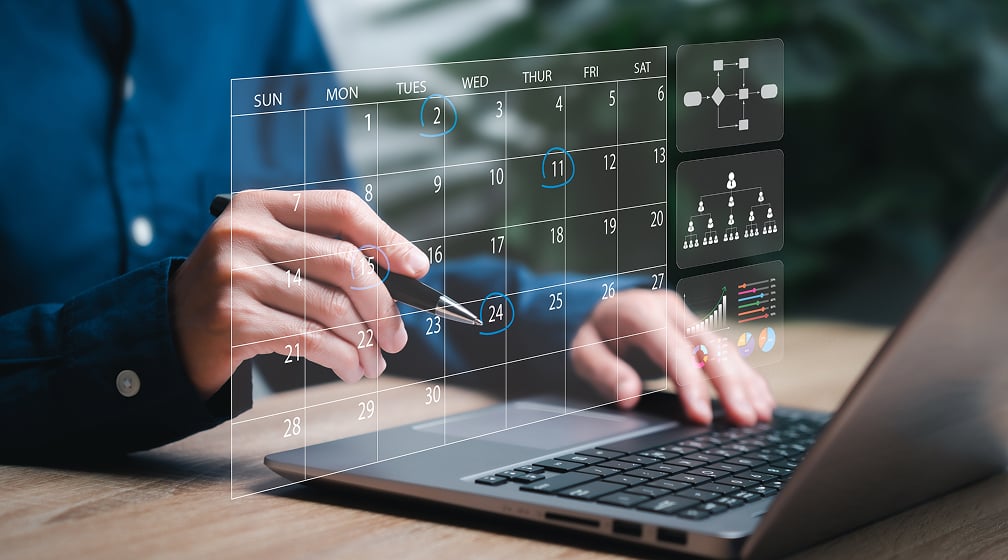What is Audio Visual Equipment?
Audio visual (AV) equipment refers to the technology used to transmit, amplify, and display audio and video content during an event. This includes microphones, speakers, projectors, cameras, video walls, switchers, and so much more. AV systems bring presentations to life, support live performances, and help ensure smooth communication in both in-person and hybrid event settings.
Why AV Technology is Essential for Events
In the context of events, AV technology plays a central role in:
- Enhancing communication: Ensures every attendee can hear and see what's happening clearly.
- Creating engagement: Dynamic visuals and crystal-clear audio keep audiences focused.
- Professional presentation: Reliable AV makes a strong impression and minimizes technical issues.
- Hybrid accessibility: easily include remote attendees and presenters.
Whether you're running a conference, concert, or commencement, the right AV gear turns ideas into experiences. Properly implemented AV can mean the difference between a forgettable event and one that makes a lasting impression. It's not just about amplification or visibility—it's about orchestrating an immersive, real-time experience for both in-person and virtual guests.
Types of AV Equipment
Before selecting your event setup, it's important to understand the different types of AV components that work together to support your vision.
Audio Equipment
Audio forms the foundation of any event communication. Without clear sound, even the most captivating visuals fall flat. High-quality audio gear ensures that every word and musical note reaches the audience with clarity.
Microphones
Microphones are selected based on the content and event format. Different microphones would be selected for speeches, singing, panel discussions, etc. Wireless microphones may be used where there could be lots of on-stage movement.- Handheld and Lavalier (lapel) are the two most widely used types of mics for almost all occasions.
- Goosenecks are placed on lecterns or tables to reach up to speakers.
- Headset Mics provide hands-free mobility with minimal visibility—perfect for formal presentations and theatre.
- Delegates or Push-to-Talk are used for board meetings, conferences, and congresses.
Mixers
- Audio mixers accept connections from all the sources including microphones, computers, video playback and conference software.
- Operators balance the audio levels and connect the outputs to the amplification system.
Amplifiers &Speakers (PA Systems)
- Amplifiers combined with loudspeakers deliver the sound to the audience.
- The type and quantity of the speakers are selected based on the size of the venue, the number of attendees and the type of content being presented. A corporate presentation will require different equipment than a concert or large-scale commencement.
- Some speakers come with built-in amplification which can simplify the setup.
Experienced audio technicians will organize the inputs, balance room acoustics, minimize feedback, and deliver crisp, well-rounded sound.
Video Equipment
 Video allows you to tell stories, showcase branding, and keep audiences visually engaged.
Video allows you to tell stories, showcase branding, and keep audiences visually engaged.
Projectors vs. Monitors: Which One is Right for You?
- Projectors: Ideal for large-scale presentations, movie nights, and auditorium settings. Portable and flexible.
- Monitors: Great for breakout sessions, VIP areas, or areas with ambient light. Offer excellent image sharpness and plug-and-play convenience.
Consider ceiling height, room brightness, and available space when making a selection.
LED Walls & Interactive Displays
- LED Walls: Preferred over projectors in outdoor or large, bright venues. Offer vivid color, high contrast, and modular flexibility.
- Interactive Displays: Encourage audience participation at booths, workshops, and networking hubs. Touchscreens can be used for check-in kiosks, live voting stations, or custom sponsor activations.
Video Mixers and Switchers
- Video switchers accept signals from all video sources. This includes cameras, computers (e.g. PowerPoint), graphics, video playback and remote sites.
- Allows the operator to change between sources, route the signals to different screens simultaneously, overlay titles, and create picture windows (called PiPs) to show multiple sources side by side.
Cameras & Live Streaming Tech
- Cameras: Capture the action and feed the switcher. Used for image magnification (IMAG), audience reactions, and recording. High-def is still widely used, but 4k is gaining ground.
- Studio cameras are the gold standard of video capture. Operators expertly follow the action with smooth motion.
- Robotic or PTZ cameras are compact and can be operated from a remote location in the venue. These systems make it easy for one person to operate two or more cameras.
- Streaming Hardware: Includes encoders (hardware or software), capture cards, and audio synchronization tools. Useful for live broadcasting, webinar integration, or hybrid experiences.
Multi-camera setups enhance viewer engagement by offering dynamic angles, zoom-ins, and cutaways. Events benefit from real-time switching and live overlays.
How your AV Production Team Will Choose the Right Equipment
Assessing Your Needs: For Events
Equipment is selected in careful alignment with your event goals:
- What type of event is it—informational, inspirational, entertaining?
- Will people be speaking or performing
- Helps select the audio system
- Will people be presenting media?
- Helps select the display system
- Do you need to video record or broadcast to a remote audience?
- Helps select cameras, video hardware, and video switcher
- What is the size of the venue and the number of audience members? The larger the venue, the more amplification and screen size are needed. Outdoor events require weatherproof gear.
Event purpose informs your AV priorities. For example, award ceremonies need spotlights and crisp speech reproduction, while a product launch may demand synchronized visuals, music, and lighting.
Key Factor: Budget
Balance between professional quality and affordability. Event budgets can range widely, and it’s important to discuss finances up front. This allows your AV Production Partner to select equipment and services to best match your technical AND financial needs.
Use the HB Live AV Calculator to plug in your event type, audience size, and space requirements. It instantly suggests optimal AV combinations, helping you make data-driven decisions.
Estimate Your Event Budget
Get a quick estimate with your easy-to-use budget calculator.

Additional Considerations When Planning AV for Events
Staffing and On-Site Support
Choosing the right AV equipment is only part of the equation. Equally important is having the right personnel to operate it. Qualified AV engineers ensure:
- Smooth transitions between speakers and media
- Troubleshooting on-the-fly for unexpected issues
- Real-time adjustments to sound levels and lighting cues
Depending on the final technical requirements, your event crew may vary and include:
- An audio engineer for mixing live sound
- A video technician for camera and switching control
- Camera Operator(s)
- Media Operator
- A projectionist or LED wall tech for display operations
- An AV director or show caller to coordinate timing with presenters and performers
- Setup and Tear-down crew
Power & Infrastructure Requirements
Powering your AV setup requires careful coordination with your venue. Your AV Production team will determine if you can utilize wall outlets, require beefier power distribution tied into the main power panel, or even the use of a generator.:
If your event includes live streaming and/or hybrid elements, a wired internet service will be required.
AV Logistics and Timing Considerations
In addition to selecting the right equipment, it's essential to develop a detailed AV logistics plan. This involves coordinating delivery times, loading dock access, and scheduling setup and teardown to align with venue rules and your event timeline.
Important timing questions to answer:
- When can AV teams access the venue for setup?
- Are there noise restrictions during setup or rehearsal?
- How much time is allocated for testing and calibration?
- What is the detailed event schedule from doors open to encore?
- When does teardown need to be completed by?
Many venues impose strict move-in and move-out windows, which can impact your AV installation timeline. Make sure to coordinate closely with both the venue and your AV team to avoid penalties or rushed setups. Include buffer time in your schedule to account for potential delays, especially when managing large LED walls, complex truss systems, or multi-room setups. Don’t forget to schedule time for the crew to get a meal break!
Communication With Your AV Partner
Effective communication with your AV provider is crucial. Share your run-of-show, venue diagrams, session formats, and creative vision early. The more your AV team understands your vision and plans, the better they can tailor the technical delivery.
Helpful materials to provide:
- Floor plans with tech station location, seating and stage diagram
- Timelines and cue sheets
- Slide decks or video files in advance
- Headshots of presenters to help the crew recognize who is on stage
- Names and contact info for your production team, identifying the main decision maker
Schedule pre-production meetings to align expectations and avoid surprises. Collaborative planning leads to smoother execution on the day.
Hybrid & Virtual Event Integration
As hybrid and virtual formats continue to thrive, AV systems must support seamless content delivery across physical and digital platforms. This includes:
- High-quality camera setups and encoding hardware
- Reliable internet connections with sufficient upload speeds
- Dedicated operator for virtual audience Q&A and polling
- Integration with streaming tools like Zoom, Teams, Vimeo, and YouTube Live
Recording sessions for on-demand access also extends the event's reach and value.
Conclusion
Audio visual equipment is the lifeblood of modern event production. From compact panel discussions to full-scale festivals, AV solutions shape how your audience hears, sees, and remembers your event.
Understanding what each system does—and how they all connect—empowers event planners to make informed, cost-effective decisions. Whether you're planning a one-off gala or recurring conference, having the right AV partner and tools ensures your message resonates long after the lights go down.
Need help building the perfect AV package? Contact HB Live today and get expert support from pre-planning to post-show wrap-up.
.jpg)



